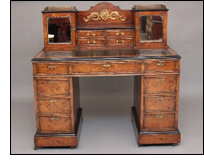Antique Desks
Posted by Gill Jones on 07/10/2013
 When I think of antique desks I think of Jane Bennett of Pride and Prejudice sitting sedately at a simple yet well-made writing bureau, or perhaps Elinor Dashwood looking out at her sister in the garden while she conducts her business at some polished desk complete with drawers, containing those all-important papers for which to write upon. They seem less important now as we no longer write letters by hand – more’s the pity. However we do still need desks from which to place our laptops and a desk is always an investment, even better if it comes with drawers for there is always something to go in them.
When I think of antique desks I think of Jane Bennett of Pride and Prejudice sitting sedately at a simple yet well-made writing bureau, or perhaps Elinor Dashwood looking out at her sister in the garden while she conducts her business at some polished desk complete with drawers, containing those all-important papers for which to write upon. They seem less important now as we no longer write letters by hand – more’s the pity. However we do still need desks from which to place our laptops and a desk is always an investment, even better if it comes with drawers for there is always something to go in them.
Any contemporary desk may do for some, but alas they haven’t the class or the memories of an older desk from a time gone by, when all your thoughts and dreams would be written on paper and your love would be forever forged in ink on the written page. The workmanship of an antique desk before the mass production techniques we have become accustomed to is something to admire and want, and if an opportunity comes up to purchase one within budget then it’s off to the auctioneers we go, or antique shop perhaps, whichever one has the desk of my dreams.
In the 1800s Thomas Chippendale came into the world of furniture and we are still using his furniture today, his desks are some of the most sought after in the world and rightly so. His very personality was built into each design and with the exquisite carving, a Chippendale desk become extremely desirable and still is.
Desks came in all shapes and sizes with the smallest fitting snugly in a hallway perhaps serving the purpose of quick letter writing rather than for more serious work. Some came with their own cubbyholes where mail could be placed for sorting, with other compartments serving different functions. A desk could be more than mere decoration as it would fulfil numerous tasks, especially for a larger family or someone who conducted their business at home.
Some came with castors so they could be moved around, while some would be worth more than others depending on the designer who made them and the quality of the wood used. The designers would be identified from their carvings, etches and your desk could be a talking piece, a place where everyone sat to write and conduct their daily affairs.
Collectors know what to look for when they want a desk; the carvings and the shape of the legs, the design of the writing area and of course its condition as well as the rest of the desk. The type of finish and the designer will be crucial in deciding whether or not to buy, and if you do then all of the above will play a part in how long it will last.
There are some magnificent examples on www.antiques.co.uk of some beautiful writing desks, one of which is the Edwards and Roberts Ladies Satinwood writing desk. Edwards and Roberts were a famous cabinet making duo and were the leading cabinet makers in London, while perhaps not being quite as famous as Chippendale, they still enjoyed the kind of success that came from excellent craftsmanship and exquisite carving. Although this piece may not have actually been made by Edwards and Roberts it may be have been retailed by them. This one has a beautiful finish with a drop down door that acts as a writing surface. The detailing on it is exquisite with a host of musical instruments drawn into the woodwork.
We then have the Victorian mahogany desk dated around the beginning of the 1900s. It has a Chippendale style with cabriole legs and cock-beaded drawers, it’s beautifully finished and the condition is just excellent. And how about the rather dramatic 19th century gothic oak mahogany davenport writing table desk, although smaller than the average desk, it’s the type that would fit snugly into a hallway as it does have a certain grandeur in the quality of its wood and the way it stands. There are some rather deliciously hidden mahogany drawers and a worn leather writing surface. Just the words “worn leather writing surface” makes me want to sit down and write. These desks are simply beautiful and speak of a time when the pen and ink were masters of the written word; they still have a place in our homes despite the onward march of technology and will continue to be a favourite collector’s piece.





